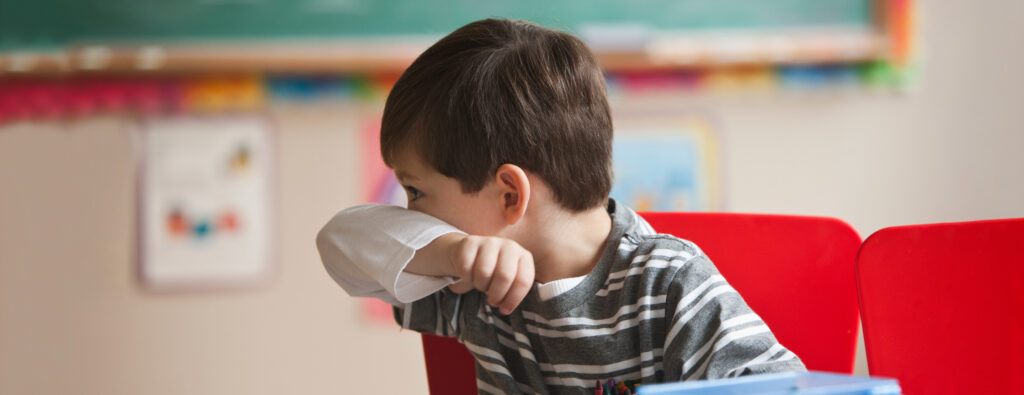Flu in Children
Childhood Influenza (Flu): A Complete Guide
Influenza, also referred to as the flu, is a respiratory infection that is extremely contagious and is caused by influenza viruses. Although children of all ages can get the flu, parents may be especially concerned because of their growing immune systems. This resource explores the signs, side effects, and recommended vaccinations for childhood influenza.
Table of Contents

Children’s Influenza Symptoms
Flu in Children
In contrast to the average cold, the flu often manifests itself as a rapid and severe illness. The following are important signs to look out for in your child:
- Elevated body temperature: This is frequently the initial indication of influenza, with readings as high as 105°F (40.5°C) or 103°F (39.4°C).
- Body aches and pains: Children who have the flu frequently have generalised body discomfort and aches in their muscles.
- Severe exhaustion: Children who have the flu frequently have low energy and a desire to spend a lot of time in bed.
- Dry cough: One of the most typical signs of the flu is a chronic dry cough.
- Sore throat: The flu can cause scratchiness and soreness in the throat.
- Headache: Children who have influenza often complain of headaches.
- Loss of appetite: Due to nausea or general discomfort, children who have the flu may stop being interested in eating.
Additional symptoms in younger children (under five years old) could be:
- stuffy or runny nose
- diarrhoea or vomiting
- Earache
It’s crucial to remember that each child may suffer different symptoms, and some may just have a few.
Influenza Complications in Children
Flu in Children
The majority of healthy kids get over the flu in a week, but occasionally things go wrong. The following are some possible issues to be mindful of:
- Pneumonia: The lungs are weakened by influenza, which increases their vulnerability to bacterial infections such as pneumonia. Hospitalisation may be necessary in the event of a significant consequence.
- Ear infections: Children who have the flu are more susceptible to developing otitis media, or ear infections.
- Sinusitis: After the flu, an inflammation of the sinuses can develop as a secondary infection.
- Bronchiolitis: The flu can cause bronchiolitis in young children, which is an inflammation of the lungs’ tiny airways that results in wheezing and breathing difficulties.
- Severance of long-term medical diseases: Children who suffer from long-term medical disorders, like asthma or heart disease, may see an exacerbation of their flu symptoms.
Flu in Children Rarely, the flu can cause Reye’s syndrome, a dangerous illness that affects the liver and brain and may be fatal.
Recommended Vaccinations for Children
Flu in Children
Vaccinating children against the flu every year is the greatest approach to protect them against it. Every child six months of age and older should receive a yearly flu vaccination, according to the Centres for Disease Control and Prevention (CDC).
Here are some more vaccination-related points to consider:
- The flu vaccination comes in two primary varieties: the live attenuated influenza vaccine (LAIV nasal spray) and the inactivated influenza vaccine (flu injection).
- For the majority of kids, the flu vaccination is recommended.
- It is not possible to vaccinate children younger than six months against influenza.
- In the first year after receiving the vaccine, some kids could need two doses.
- Pregnant women, healthcare workers, and youngsters with long-term medical issues should all get vaccinated.
- It is imperative that you discuss the best immunisation plan for your child with their paediatrician.
Extra Advice on Protecting Kids from the Flu
Flu in Children
Here are some useful suggestions to help stop the spread of influenza in kids in addition to vaccination:
- Handwashing frequently: Stress to your kids the value of properly washing their hands for at least 20 seconds with soap and water.
- Sneeze and cough politely: Urge your youngster to cough or sneeze into a tissue or into their elbow and to throw away the tissue right away.
- Refrain from touching sick persons closely: Keep your kids away from people who seem to be suffering from the flu.
- Scrub and sanitise surfaces: Toys, doorknobs, counters, and other regularly touched surfaces should all be cleaned and disinfected on a regular basis.
Flu in Children
You can take precautions to safeguard your child and guarantee a healthy flu season by being informed on the signs, problems, and vaccine recommendations for influenza in children. Never forget that getting specialised guidance and a diagnosis from your child’s paediatrician is always advised.


